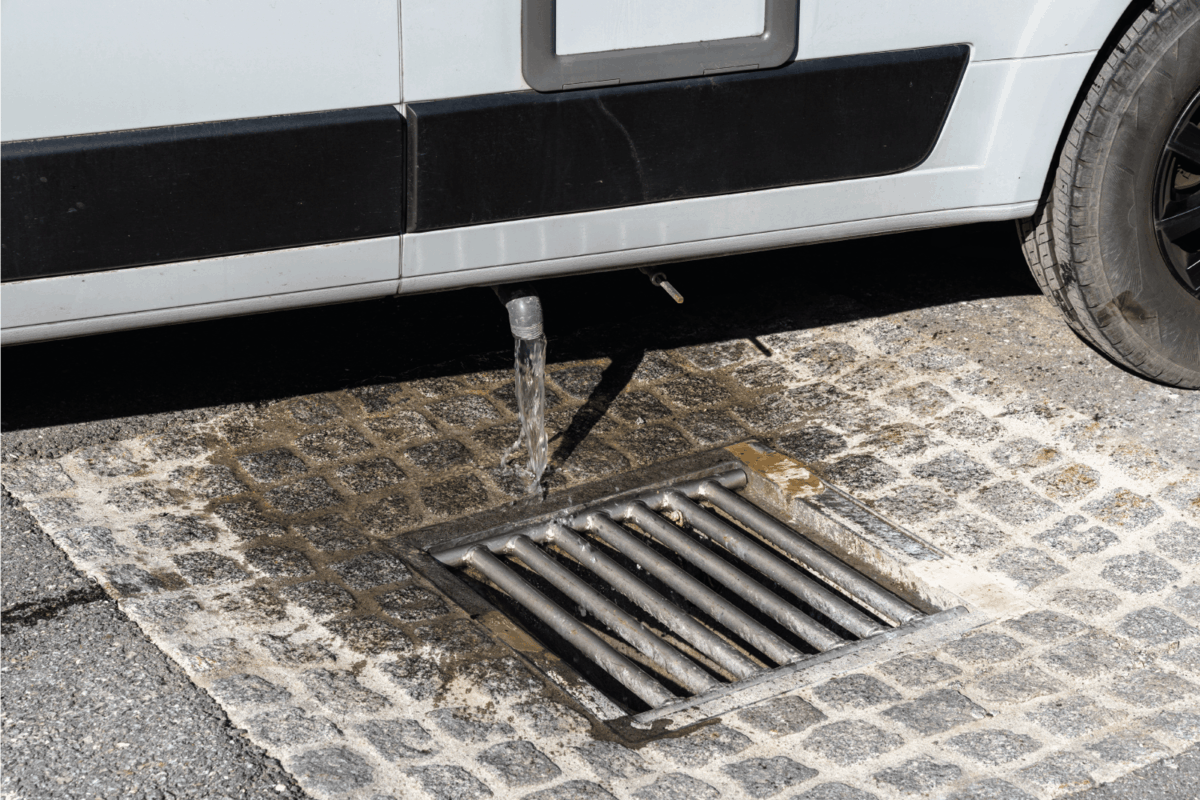Many people like using their RV to explore. For some, that's the appeal - you can go anywhere and have everything you need. Why stick to campgrounds when there's a whole big world to see? Well, until you need to dump your holding tanks anyway. So how long does a grey water tank last without hookups, and when do you need to find a dump station?
Just how long a grey water tank will last before you need to find a hook-up varies. Expect each camper to use 5-10 gallons a day, not including showers. With more careful conservation, it's possible to cut down to 5 gallons maximum. How long this takes to fill your tank depends on:
- The size of the grey water tank. Depending on your RV, the tank could hold 10 or 100 gallons.
- How many campers there are.
- How careful you are with water usage. Simple things like turning the water off when you brush your teeth can save gallons of water.
- If and how often you shower in the RV. Showers can use one and a half gallons per minute, so a few people taking long showers can fill a tank in a day.
With all these factors involved, it's impossible to make one generalization. Some people find that their tank lasts only a couple of days. Others can stretch for two weeks. But finding out the tank size, and assuming 10 gallons per person, at least provides an estimate.
Keep reading to learn more. We'll cover how to tell when your tank is full and what happens if you overfill it. This article will also explain the rules for dumping gray water. Do you really have to go to a dump station? And how often does the tank need flushing? Read to find out!

How To Tell How Much Water You Use
The obvious, simplest way to tell how fast you fill your gray water tank? Just fill it! If your tank gets half full in 2 days, then a whole tank takes about four days to fill. Keep an eye on the tank and do the math for a relatively accurate estimate of how long your tank lasts.
But if you're going somewhere without hookups, that doesn't always work. You can't just dump the tank when it's full - you have to make sure it doesn't get full too fast in the first place. In this case, the only way to really know for sure how much water you're using every day is a flow meter.
For this to work, you still have to hook up to a fresh water source and measure how much water you use - how much it takes to do dishes, shower, etc. But once you keep a log on just how much water everything takes, you'll know where and how to conserve water when you're away from a dump station.
Use a flow meter like this one, attached to a hose, for an accurate reading of how much water everyday tasks use:
Click here to see this flow meter on Amazon.
What Happens If You Overfill The Gray Water Tank?
Most holding tanks have sensors that let you keep track of just how full the tank is getting. If you keep an eye on the indicators, you'll know when the tank is 1/4 full, 1/2 full, and so on. As a result, you should be able to tell about how many days it takes to fill the tank - and avoid being surprised by an overfill.
But if you do get caught off guard, a full tank will be pretty apparent. The greywater, having nowhere to drain, will instead back up into the sinks and showers. At that point, you have no choice - dump the tank and fast because you can't run any more water till you do.
If you're interested, also check out: What Happens If You Overfill the RV Waste Tank?
Can You Dump Gray Water On The Ground?
You can rarely, legally dump gray water on the ground. The practice is straight up, undebatably banned by most locations - including the U.S Forest Service, Army Corps of Engineers, and National Parks Service.
And even if you happen to be on a location that permits it, such as private property, it can still violate that area or state's law. Always check the specific legality of your situation before assuming that you can dump grey water - you probably can't. The only public entity in the US that permits it - sometimes - is the Bureau of Land Management, and even then, individual state laws take precedence.
Even if you can, it doesn't mean that you should. Many campers frown on the practice, whether or not you'll face any legal consequences for it. It's regarded, by many, as at least bad manners - and in the worst case, dangerous.
For one, the water dumped usually includes pollutants, which can destroy plants and trees and run off into a nearby waterway. The waste can be harmful to wildlife - food scraps from the kitchen and chemicals from the shower mix, potentially encouraging wildlife to eat dangerous toxins. Just the sheer amount of water being dumped can cause erosion. And, it smells - possibly attracting dangerous animals and ruining the area for other campers.
For more about dumping the tanks, read: Where Can You Dump RV Tanks? and How to Empty RV Holding Tanks at Home.

Should Grey Water Tank Valve Stay Open?
Greywater should always be dumped into the sewer, either directly or through a dump station. Never leave your grey water tank valve open to drain out indiscriminately.
The only time your tank valve should be left open is when you are hooked directly into the sewer connection at a campground. With a hose in place that takes your greywater directly into the sewer, feel free to leave the valve open. Then, you won't need to worry about dumping a full tank later.
But remember, this is for grey water only. Never leave your black tank open - the liquid will never accumulate enough to flush out the solid waste that way. You need to fill your black tank before dumping, letting the gravity and weight of the liquid in the tank clean everything out.
If you leave the valve open, make sure that the sewer can't vent any foul odors back through. Use a sewer hose support to prop up the hose. But leave a small section of the hose nearest the valve hanging down, unsupported.
Gravity then forces water to accumulate in this area of the hose. This blocks any septic smells from venting back into the RV.
Click here to see this sewer hose support on Amazon.
Not sure exactly how it works? Watch this helpful video by the RV Geeks:
How Do You Flush A Grey Water Tank (And How Often?)
The grey water tank holds relatively clean water. It still needs to be disposed of properly in a sewer, of course. But there isn't the same bacteria and fecal waste as found in the black water tank. As a result, a thorough cleaning every time the tank is dumped isn't necessary.
But make no mistake, it's still a source of germs and contamination. Some RVs come with a power-flush system that does the hard work for you. If so, there's no harm in using it frequently to your tank in top shape.
If you have to do the cleaning yourself, you can typically wait for several dumps. Occasionally fill it with soapy water or diluted bleach water. A long drive can be a perfect time. The motion of the RV helps get that half-full tank of soapy water cleaning every nook and cranny.
Always make sure to clean it out well if the RV is going to be sitting idle for a while. Sanitize the tank at least once a year, using one cup of bleach for every 15 gallons of water in the tank. Dump the tank first and add "clean" water for cleaning. Like above, drive the RV around, letting the movement do the cleaning.
As needed, you can also add a product like this to help cut grease and deodorize:
Click here to see this tank treatment on Amazon.
In Closing
A greywater tank can last a couple of days or weeks, depending on several factors. The most obvious is the size of the holding tank, which can be 10 or 100 gallons. It also varies based on how many people use water in the RV and how careful they are with water conservation. With effort, it's possible to limit water usage to less than 5 gallons a day. A more typical estimate is 5-10 gallons, though showers can easily inflate this number.
When the grey water tank is full, it backs up into the sinks and showers until the tank is drained. Always dispose of greywater into the sewer at an appropriate dump station. Never dump grey water on the ground - it can be toxic, smelly, and attract dangerous animals (potentially poisoning them).



